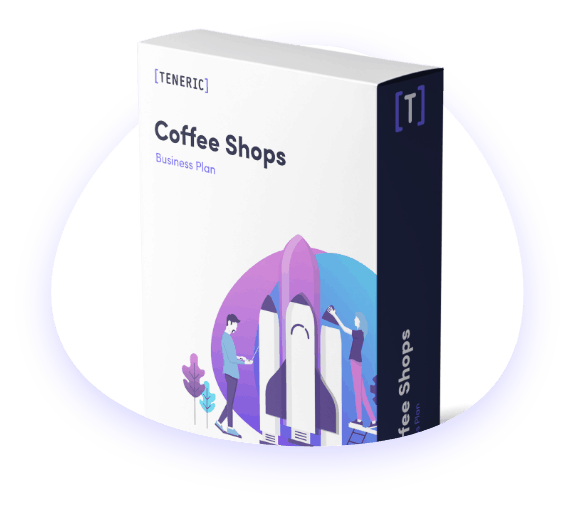If you’re passionate about great tasting coffee and love serving people, then opening a coffee shop could be a great business venture for you. The coffee industry in the UK has grown dramatically over recent years, and shows no signs of slowing down, representing a great opportunity for coffee-loving entrepreneurs.
In the UK, we drink around 95 million cups of coffee every day, and café culture is big on the high street. 80% of people who visit coffee shops go on a weekly basis, and 16% get their caffeine fix on a daily basis.
Before you dive in and start dreaming about your coffee shop empire, the first step is to create a coffee shop business plan which will get you the funding and support you need to see your café business flourish.
We’ll guide you through each step of creating your own business plan, from planning your sales and marketing strategy, to understanding your ideal customer, to identifying your competitors. As a business owner there’s a lot to take on, but we’ll walk you through everything you need to know.

As we know, coffee shops are part of a growing market and represent an exciting opportunity for coffee shop owners. The coffee shop market in the UK is expected to hit a £15 billion turnover by 2025.
But the first question you need to ask yourself is: Is this the right business for me?
A business plan will give you clarity on your competitors and help you reach your ideal customers, and show how you can run a successful coffee shop.
Your start-up costs will depend on things like the kind of equipment you need to buy, how many staff you need and the size of your premises. Start-up costs generally run between £20,000 to £100,000 in the UK.
This may sound scary, but there are ways that you can save money. Leasing and buying second hand equipment is just one simple way to prevent overspending.
A business plan for your coffee shop will help you anticipate your costs and budget appropriately. We’ll help you work out how to raise capital for your business and take into account your current financial situation.
We’ll run through every step you’ll need to take to open your coffee shop. Remember, if you’re planning to secure funds from a bank it’s essential that the business plan for your coffee shop is as thorough as possible.
Plus 25 ways to market your coffee shop for free!
Below, we’ll walk you through an example of a coffee shop business plan. Remember, this is only a guide. You should take the time to write a business plan for your coffee shop in much more detail.
When it comes to your café business, we really believe that you can’t over plan for your enterprise
This is a short, snappy summary that grabs the readers attention and acts as your business pitch. You want a concise overview, not a novella. Investors hear hundreds of these pitches, so you’ll need to think about how to make yours stand out.
Use your executive summary as a chance to shout about what a great opportunity your coffee shop is and what sets you apart.
A company overview (or company summary) gives you the chance to introduce yourself, your business and any key stakeholders. This “meet and greet” will tell your readers who you are, what you do, and who your customers are.
Just like your executive summary, this should be short and punchy. Your reader needs to quickly grasp who you are and what you do.
Another top tip for writing a company overview is to put yourself in your reader’s shoes: Why should they put their money into your coffee shop?
To answer this question, focus on areas you know will interest your potential investors.
Use this section of your business plan to show what you want to accomplish, but remember to keep it high-level. Don’t overload your reader with too many details.
Feel overwhelmed? Not sure where to start? Panic not. Download our coffee shop business plan for instant access.
No man or woman is an island, and you’ll need the support of a great team to help make your coffee shop business a success. In this section you’ll detail your management team, staff and resources.
One more thing, it’s unlikely that your team will be working for free, so don’t forget to include details on things like salaries, benefits and pensions.
Before launching any business it’s vital that you know your market. This section will help you understand the threats and opportunities in your market.
You’ll need to get a grip on your competitors, your ideal customer and whether the market can support and sustain your business.
Let’s take a look at your ideal clients first.
Sketch out your target customer. Are they parents meeting after the local school run? Or busy office workers grabbing a quick espresso on the way to work? You need to know whose needs you are serving so that you can make a targeted offer.
Next, you need to scope out the competition…
There are literally thousands of coffee shops across the country. As of 2019, there were 10,604 non-specialist outlets in the UK, up by 292 shops from 2018. So how will you stand out from your competitors?
One top tip for writing this section of your business plan is to put yourself in your customer’s shoes. What do they need from your business? What is the problem that needs to be solved (e.g. they need a hot drink to set them up for the day). How do you solve that problem better than your competitors?
You need to think short-term and long-term here. Where do you want to be in a month or six months? A year or five years? And how will you get there?
In this section, list the specific steps you’ll need to take to achieve your objectives.
You can keep track of your goals and objectives using the S.M.A.R.T criteria.
To help you determine your business objectives, here are some questions to ask yourself:
Demonstrate how you will woo clients to your coffee shop and establish a loyal customer base.
Deciding what equipment you need to open your coffee shop will give your investors a clear idea of how much funding you need to get started.
The key here is to be realistic, and not overspend. Consider the size of your market and the needs of your customers before buying anything.
Let’s get real here, your backers want to see cold, hard numbers, and feel confident that they will get a return on their investment. Spelling out your financial future can be tricky, but it’s an essential part of your business plan.
Don’t limit yourself to a single source of income. Obviously you’ll make money from selling your coffee, but consider how you can diversify your income.
Remember, your financial forecast needs to be well-informed and attainable. But it doesn’t need to be 100% accurate. Things will likely change over the next few years and you’ll need to adapt. This plan will give your readers an idea of what you expect to happen in the future.
We’ve taken all of the hard work out of planning your finances for your coffee shop.
Download your coffee business plan template instantly below.
Now, you need to consider how you will secure funding for your business idea. Where is the money for your business coming from?
Are you funding your coffee shop with your own cash, or is the money coming from outside investment? Your backers will need to know exactly where the cash will come from, and how much you still need to raise.
You need to be clear to your investors about how much money you need, now and in the future. Detail how you’ll use any investment, such as paying for supplies or equipment, paying debts or hiring staff.
You’ll also need to balance your funding request between making sure you have enough to survive, but not more than is necessary. Ask for what you need, but don’t get greedy!
If you need an example of how a coffee business plan might look, we’ve pulled together a small Word template that you can use to get you started for your coffee business plan outline.
Launching your own business can be a nerve racking venture. The coffee shop market is a crowded place, but the good news for new business owners is that people love an independent coffee shop. Research has found that 7,022 independent cafés operate in the UK, with a value of around £2.4 billion.
By creating a well-thought out business plan you will get your business off the ground and help you to anticipate any future problems. A succinct business plan will show potential backers that you’re a solid investment and set you up for future success.
